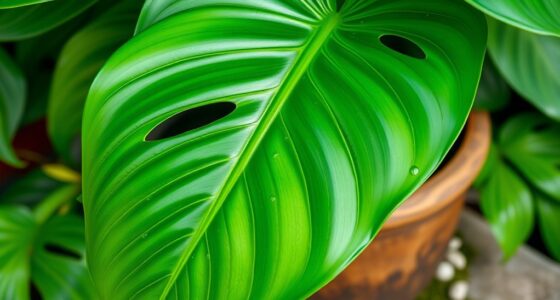To keep your Calathea thriving, provide medium to bright indirect light avoiding direct sun, and water when the top inch of soil feels dry using room temperature, distilled, or rainwater. Maintain humidity around 50-60% with misting, humidifiers, or grouping plants, and keep temperatures steady between 65-85°F. Address pests early and avoid sudden environment changes. For detailed tips on fertilizing, repotting, and creating the perfect space, keep exploring further.
Key Takeaways
- Provide bright, indirect light near east or north-facing windows to support vibrant leaf patterns and healthy growth.
- Keep soil consistently moist with room temperature, distilled or rainwater, avoiding overwatering and sogginess.
- Maintain humidity levels at 50-60% through misting, humidifiers, or plant grouping to prevent leaf browning.
- Fertilize monthly during spring and summer with diluted, balanced fertilizer; avoid fertilizing in winter.
- Regularly inspect for pests, address leaf issues promptly, and repot every 1-2 years in well-draining, nutrient-rich soil.
Understanding the Light Requirements for Your Calathea
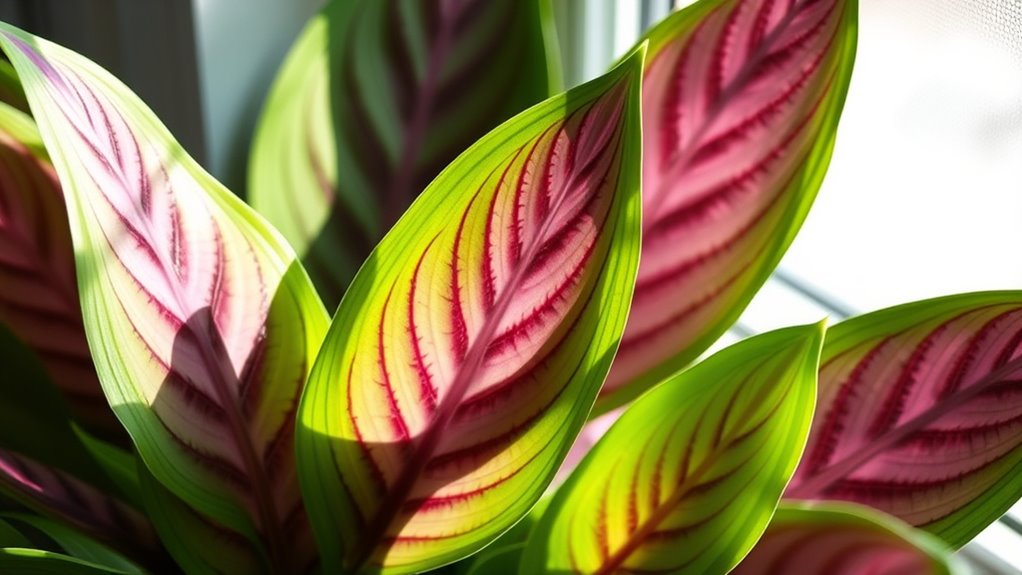
To keep your Calathea healthy and vibrant, understanding its light needs is essential. In its native habitat, the rainforest, it thrives in medium to bright indirect light, which mimics filtered sunlight. Direct sunlight can cause leaf burn, leading to discoloration and damage. You should avoid placing your Calathea in direct sun, as its delicate leaves are sensitive to intense rays. Instead, position it near east or north-facing windows where it can receive gentle, filtered light. While it can tolerate low indirect light, expect slower growth and less vibrant foliage. Proper lighting helps prevent issues like leaf scorch and supports the plant’s overall health and aesthetics. Adjust the plant’s placement based on the available light to maintain its striking leaf patterns and movement. Providing the right amount of indirect light ensures your Calathea remains lush and healthy.
Proper Watering Techniques for Vibrant Foliage
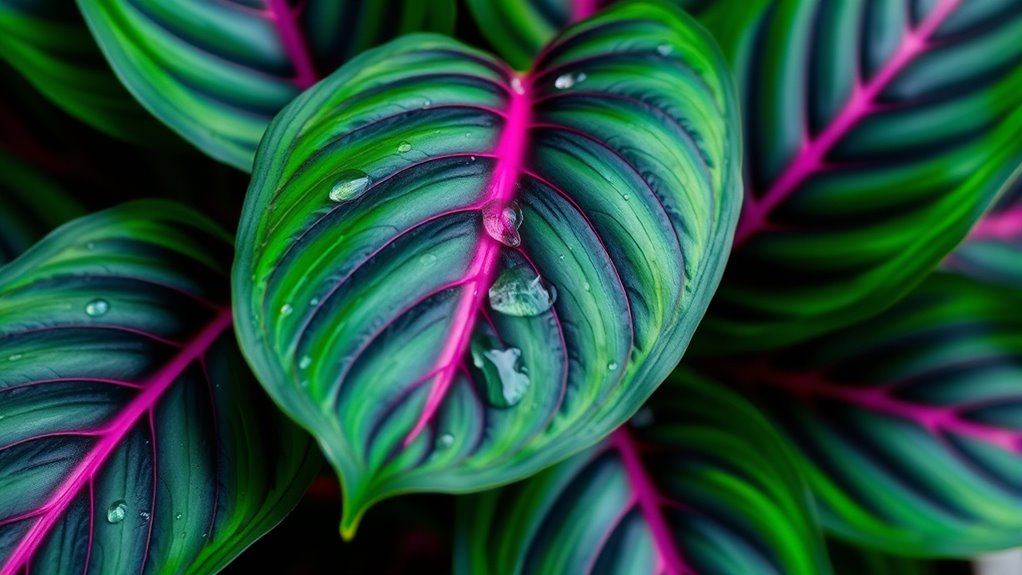
Ensuring your Calathea receives the right amount of water is key to maintaining its vibrant foliage. Water the plant when the top two inches of soil feel dry to prevent overwatering and root rot. Use room temperature, distilled, or rainwater to avoid chemical buildup that causes leaf browning. Water thoroughly until excess drains from the bottom, then discard any standing water. Adjust your watering schedule seasonally: increase during warmer months and reduce in winter dormancy. Let the soil dry halfway between waterings to keep moisture consistent without waterlogging. Proper watering also involves maintaining adequate humidity. Use this guide to help you manage water and soil health:
| Watering Frequency | Soil Moisture Level | Humidity Tips |
|---|---|---|
| Seasonally adjusted | Dry halfway between | Increase humidity |
| When topsoil feels dry | Avoid soggy soil | Use humidifier or pebble tray |
Being aware of soil drainage ensures your Calathea’s roots do not sit in water, preventing potential issues. Regularly monitoring soil moisture levels can help prevent over- or under-watering, promoting healthier growth.
Maintaining Ideal Humidity and Temperature Conditions
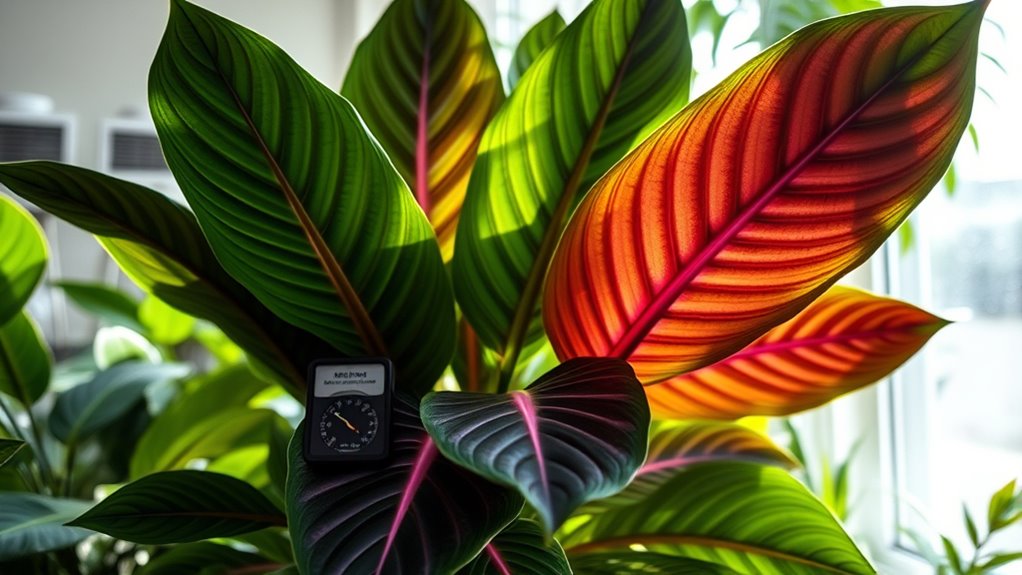
To keep your calathea happy, you need to maintain humidity levels of 50-60%. Regular misting and using humidifiers or pebble trays can help boost moisture in the air. Additionally, choosing a suitable lighting environment can significantly impact its health and vibrancy. Proper protective styling benefits can prevent stress and damage to the plant’s leaves from environmental fluctuations. Also, keep the temperature steady between 65°F and 85°F, avoiding drafts and sudden changes. Ensuring consistent care aligns with fire safety regulations, emphasizing the importance of safe environmental management for thriving growth. Incorporating celebrity lifestyle insights on environmental control can offer additional tips for optimal plant care and creating a thriving indoor space.
Boost Indoor Humidity
Maintaining the right humidity levels is essential for keeping your Calathea healthy and vibrant, especially since they thrive in environments with 50-60% humidity. To boost indoor humidity, try misting the leaves with room-temperature, filtered, or distilled water regularly. Using humidifiers can also help maintain consistent moisture levels. Placing pebble trays filled with water beneath your plant creates a humid microenvironment. Grouping your Calathea with other plants enhances local humidity naturally. Avoid placing it near vents, heaters, or air conditioners, which dry out the air and cause fluctuations. Here’s a quick overview:
| Method | Benefit |
|---|---|
| Misting | Increases moisture directly on leaves |
| Humidifiers | Maintains constant humidity levels |
| Pebble Trays | Creates a humid microclimate |
| Plant Grouping | Boosts humidity naturally |
| Avoid Dry Air | Prevents humidity fluctuations |
Additionally, choosing proper soil, such as a well-draining mix rich in organic matter, supports healthy root systems and optimal moisture retention. Incorporating humidifying techniques, including the use of humidifiers and pebble trays, that optimize the environment can further enhance plant health and longevity. A balanced environment with stable humidity and temperature ensures your Calathea remains vibrant and thriving.
Regulate Temperature Consistently
Keeping your Calathea healthy requires consistent temperature control, as sudden shifts can stress the plant and cause leaf damage. Maintaining a consistent temperature within 65°F to 80°F (18°C-27°C) helps prevent unnecessary plant stress. Automation technology can assist in maintaining precise climate conditions, ensuring optimal growth. Additionally, using climate monitoring devices can provide real-time data to help you make adjustments promptly. Avoid placing your Calathea near drafts, open windows, or vents that cause temperature fluctuations. Use insulation, curtains, or a temperature-controlled room to shield it from cold drafts and hot spots. Regularly monitor your indoor environment with a thermometer to ensure conditions stay within the ideal range. Climate control is essential for preventing stress and promoting healthy growth. Sudden drops below 60°F (15°C) can harm the plant, so keeping the environment stable year-round is essential.
Managing Common Problems and Plant Health

When your calathea shows leaf issues, it’s essential to identify whether it’s due to watering, humidity, or pests. Regularly inspecting your plant helps catch problems early before they worsen. Additionally, maintaining the right seasonal conditions and avoiding sudden environmental changes can significantly reduce stress on your calathea. Proper lighting conditions are also crucial for healthy growth, as inconsistent or inadequate light can lead to leaf discoloration. Implementing proper watering, humidity, and pest prevention strategies keeps your calathea healthy and thriving, and incorporating sound healing science principles like gentle vibrations may also support overall plant health. Recognizing the importance of audiometric testing can help diagnose underlying issues that affect plant health indirectly through environmental factors. Advances in machine learning algorithms are increasingly used to monitor and optimize plant care environments, leading to healthier indoor plants.
Troubleshooting Leaf Issues
Troubleshooting leaf issues in your calathea involves quickly identifying common symptoms and understanding their causes. Wilting, curling, or dry soil often means you’re underwatering or your humidity is too low. Using a humidifier or pebble tray can help maintain the ideal moisture level for your plant. Proper humidity levels are essential for preventing leaf curling and browning, as calatheas thrive in high-humidity environments. Yellowing leaves, black bases, and wet soil point to overwatering and possible root rot. Leaf spots can be caused by fungal infections or mineral buildup from hard tap water. Pests like spider mites or mealybugs may also damage leaves, visible through small spots or webbing. Recognizing signs of plant stress early can prevent further deterioration. To keep your calathea healthy, regularly inspect your plant for discoloration, spots, or pests, and adjust watering and humidity as needed. Promptly addressing these symptoms helps prevent further issues and maintains vibrant, thriving foliage.
Pest Prevention Strategies
Regular inspections are vital for preventing pest problems on your calathea. Check the calatheas leaves regularly, especially underneath, for signs of pests like spider mites, mealybugs, and aphids. Early detection allows you to tackle infestations before they spread.
For effective pest prevention, treat any issues promptly using neem oil or insecticidal soap, making sure to cover both the tops and undersides of leaves.
Maintaining proper plant care—such as consistent watering and ideal humidity—helps strengthen your calathea’s defenses against pests.
Keep the environment clean by wiping leaves with a damp cloth and removing fallen debris, which reduces pest habitats.
Quarantining new or affected plants is also essential to prevent pest spread and safeguard your healthy calatheas.
Fertilizing and Feeding Your Calathea
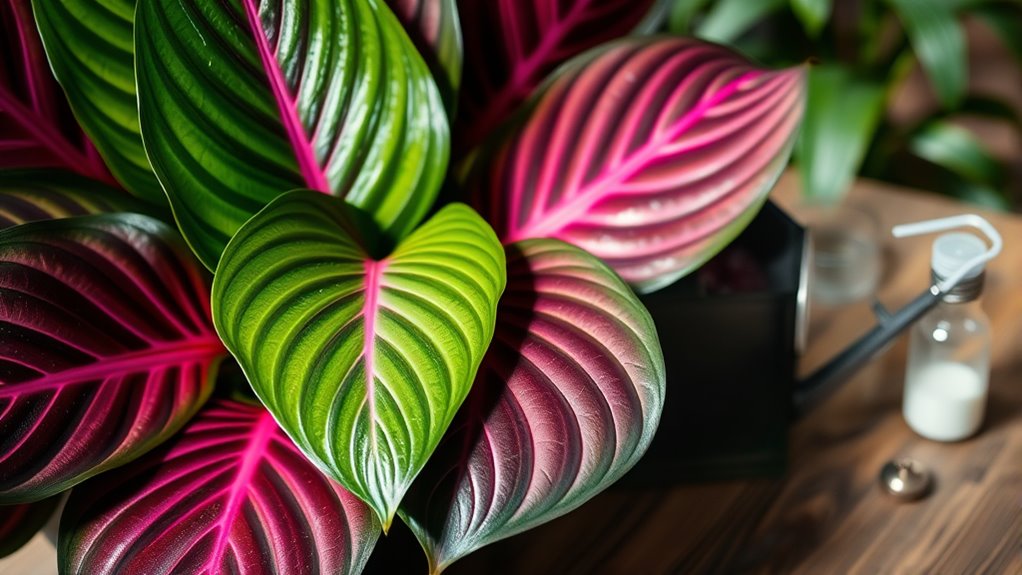
Fertilizing your Calathea properly guarantees healthy growth and vibrant foliage. During the growing season, spring and summer, feed your plant once a month with a balanced, water-soluble liquid fertilizer diluted to half strength.
Always water thoroughly before applying fertilizer to prevent root burn, and consider flushing the soil occasionally to remove excess salts.
Avoid fertilizing in winter, as growth naturally slows, and unnecessary feeding can cause nutrient buildup and leaf tip browning.
Use a gentle foliar feed or diluted liquid fertilizer to promote healthy leaf coloration and encourage new growth.
Keep an eye on the leaf tips; if they start browning, cut back on feeding or adjust your watering practices to maintain ideal health and lush foliage.
Repotting and Grouping for Optimal Growth
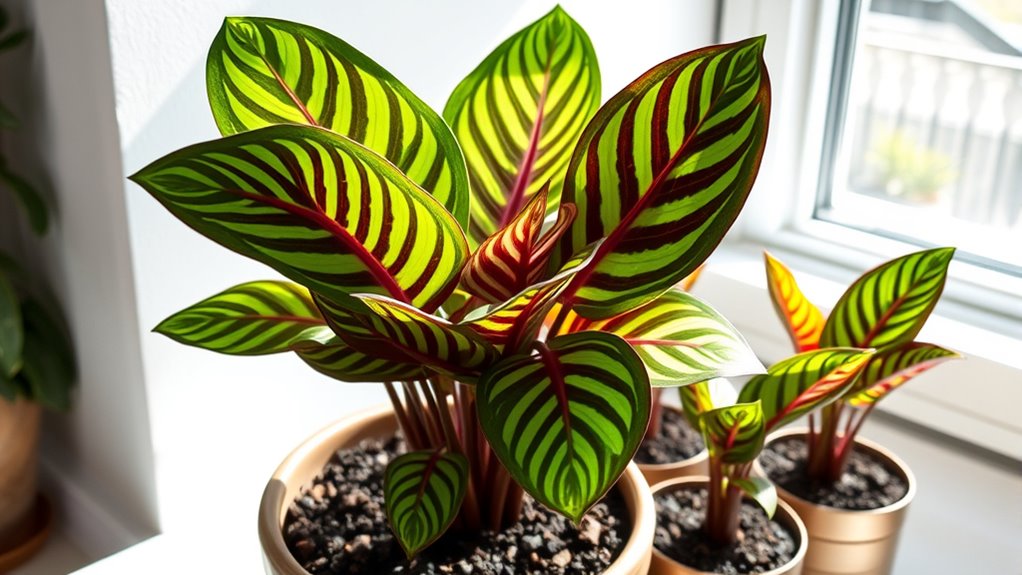
Proper repotting and grouping are key steps in maintaining your Calathea’s health and encouraging vibrant growth.
When repotting, choose a slightly larger pot with drainage holes and fill it with nutrient-rich, well-draining soil to promote healthy roots. Repot every 1-2 years to refresh the soil and reduce salt buildup, ensuring your plant gets ideal nutrients.
Grouping your Calatheas with at least three plants helps create a micro-environment that maintains higher humidity levels, which they love. Keep plants with similar light and water needs together to simplify care and prevent environmental stress.
Regularly refresh the soil during repotting to support ongoing growth and keep your Calathea thriving in a comfortable, humid setting.
Creating a Suitable Environment for Your Calathea
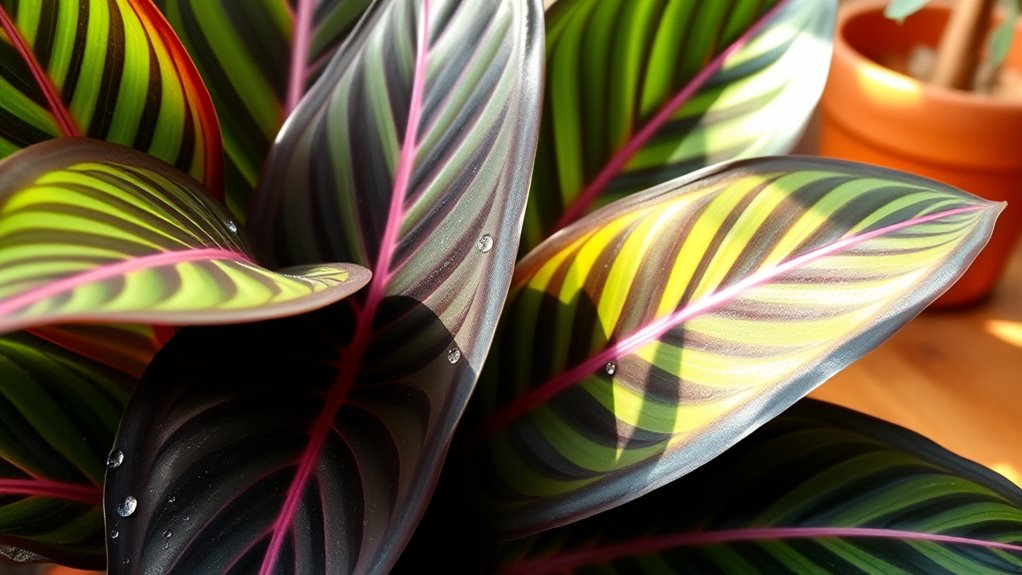
Creating a suitable environment for your Calathea involves selecting the right location and maintaining stable conditions that mimic its native rainforest habitat.
Place your plant where it gets medium to bright indirect light, avoiding direct sunlight that can scorch its leaves.
Keep the temperature between 65°F-85°F (18°C-30°C), and stay away from drafts, cold windows, or sudden temperature shifts.
To ensure healthy growth, increase humidity around 50-60% by misting regularly, using humidifiers, or grouping your Calathea with other plants.
Use well-draining, nutrient-rich soil to support healthy roots.
Maintaining consistent warmth and avoiding dry air near heating vents or air conditioners helps prevent stress.
These conditions create an ideal environment for your Calathea to thrive.
Frequently Asked Questions
How to Make Calathea Thrive?
To make your calathea thrive, you need to give it the right environment. Provide bright, indirect light and keep the humidity high by misting or grouping it with other plants.
Water it when the topsoil feels dry, using room-temperature, filtered water.
Maintain a steady temperature between 65°F-85°F and fertilize monthly during the growing season.
Avoid cold drafts and temperature swings to keep your calathea healthy and vibrant.
How Do I Keep My Calathea Happy?
To keep your calathea happy, give it bright, indirect light to safeguard its vibrant patterns.
Maintain humidity around 50-60%, and mist regularly or use a humidifier.
Water thoroughly when the top soil feels dry, using room temperature or distilled water.
Keep temperatures steady between 65-85°F, and avoid drafts.
Regularly prune dead leaves and watch for pests to ensure your plant stays healthy and lively.
Should I Cut the Brown Tips off My Calathea?
Should you cut the brown tips off your Calathea? Absolutely! Removing those brown tips can make your plant look like a showstopper, not a sad, neglected leaf.
Use sharp scissors to trim only the affected areas, following the leaf’s natural curve. This simple step prevents damage from spreading and encourages fresh, healthy growth.
Just be careful to avoid cutting into the green part, keeping your plant happy and vibrant.
Where Should I Place My Calathea?
You should place your calathea in a spot with bright, indirect light, avoiding direct sunlight that can scorch its leaves.
Ideal locations include shaded corners, behind sheer curtains, or bathrooms with filtered light.
Keep it away from drafts, vents, and temperature fluctuations.
Maintaining a temperature between 65-85°F and grouping it with other plants helps create a humid environment, mimicking its natural rainforest habitat for ideal health.
Conclusion
With the right care, your Calathea will flourish like a lush, vibrant jungle. Picture its striking leaves unfurling in a cozy corner, their rich patterns dancing in gentle light. By providing proper water, humidity, and love, you’ll create a thriving oasis that invites serenity and beauty into your space. Keep nurturing your plant’s needs, and watch as it becomes a breathtaking centerpiece, transforming your home into a lush, calming retreat.





